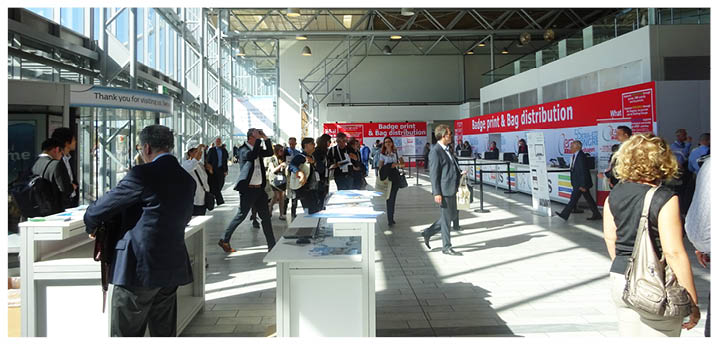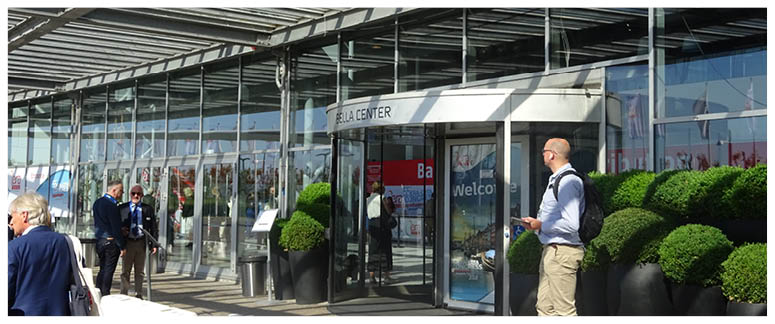This year’s host of the annual ERA–EDTA Congress was the Danish capital of Copenhagen, labelled the happiest city in the world and home to Hans Christian Andersen’s Little Mermaid. As thousands of researchers, physicians, experts, and novices flocked to the Bella Center, Copenhagen prepared for Europe’s flagship nephrology event, a 4-day spectacular packed with a bounty of the latest nephrological studies, results, and news.
The excitement was audible as the packed congress hall awaited Prof Bo Feldt-Rasmussen, ERA–EDTA President, University of Copenhagen, Copenhagen, Denmark, to take to the stage. ERA–EDTA returned to Copenhagen for the first time since 2002 and Prof Feldt-Rasmussen explained that with 6,547 delegates in attendance and >2,000 abstracts and posters being presented during the event, the ERA–EDTA Congress was back, bigger and better than ever before.
Attention quickly moved to the spectacular scientific programme masterminded by the organising committee. Modern medicine, specifically nephrology, faces a number of new challenges that inspired the theme of this year’s congress: ‘kidney disease: new paradigms, new challenges, new opportunities’. The congress brought this theme to life with something for everyone to enjoy, detailing the newest techniques and methodologies, including gene editing, molecular biology, and big data. “All of this is crucial in our ongoing search for better treatment for our patients,” summarised Prof Feldt-Rasmussen. In a nephrology celebration packed with unmissable symposia, late-breaking clinical trial sessions, and presentations, ERA–EDTA 2018 attempted to look at the field from a new direction, innovatively tackling the problems faced by the field.
With mounting pressure on governments and industry, ERA–EDTA turned the spotlight away from the operating table and towards the environment. The impact of medicine on the environment made the ERA–EDTA Congress agenda for the first time this year: “At the global level, the healthcare sector also has a clear negative impact on the environment,” explained Prof Peter Blankestijn, University Medical Center Utrecht, Utrecht, Netherlands. Prof Blankestijn highlighted the key areas of dialysis and home healthcare that could be changed to decrease the effect nephrology has on the environment. The inclusion of the environmental impact of medicine at such a high-profile event will surely induce a domino effect, triggering other specialities to consider the impact of their profession on the environment.
For some, there was an additional triumph to celebrate this year, as the annual ERA–EDTA awards were presented. Prof Jürgen Floege (Germany) was recognised for his outstanding clinical contribution to nephrology; Prof Hans-Joachim Anders (Germany) was awarded for his outstanding basic science contributions to nephrology; Prof Andrzej Więcek (Poland) was presented the award for outstanding contributions to ERA–EDTA; and, last but not least, Dr Shrikant Ramesh Mulay (Germany) was presented with the ERA–EDTA 2018 Young Investigators Award.
In the following Congress Review, the key findings, studies, results, and trials are discussed, providing you with the highlights from the 55th ERA–EDTA annual congress. As ever, chronic kidney disease was of paramount importance, but this year the link between cardiovascular disease and chronic kidney disease was placed under the microscope as the results of three important studies were discussed. Furthermore, the ever-growing diabetes epidemic did not escape the attention of the globe’s nephrologists, as the impact of the metabolic disorder on the kidneys was also a topic of great debate. For those of you who were not able to attend this year’s congress, we are sure this review will capture the spirit of the occasion.
The 56th ERA–EDTA annual congress will be held next year in Budapest, Hungary. The Hungarian capital and pearl of the great Danube river, home to the historic thermal spas and birthplace of goulash, will welcome you for another celebration of kidney research, and we look forward to seeing you there.

Review Confirms Recommendation for Pre-Emptive Kidney Transplant
QUESTIONS about the best treatment strategy for patients with kidney failure have been explored in a review article published during ERA–EDTA 2018 and discussed in a ERA–EDTA press release dated 24th May 2018. This article provided supporting evidence that patients who received a kidney transplant prior to commencing dialysis would benefit from this procedure in terms of extended life.
Kidney transplantation is a cost-effective, long-term procedure and demonstrates improvements in quality of life; therefore, it is logical that patients should receive a kidney transplant before beginning dialysis, a treatment plan that was encouraged by all current clinical guidelines. However, this recommendation is not based on gold-standard evidence, as the study’s lead author, Prof Rainer Oberbauer, Medical University of Vienna, Vienna, Austria, explained: “There are no randomised controlled trials proving that pre-emptive kidney transplantation is the preferred treatment for eligible patients with end-stage renal failure.” Furthermore, the existing evidence base does not resolve the question of whether dialysis vintage negatively affected graft and patient survival post transplantation.
This review synthesised the most recent studies investigating pre-emptive transplantation and the link between dialysis vintage and outcomes. The strongest evidence suggested an association between pre-emptive transplantation and a lower risk of actual graft loss (including death) when compared with non-pre-emptive transplantation. The results also showed that the latest studies, conducted within the last decade, did not indicate an association with dialysis vintage and graft survival, unlike older studies. While the majority of the recently published studies demonstrated a grade association between patient survival and dialysis vintage, any impact on functioning graft survival was not clear. The authors also highlighted an association between dialysis vintage and death post transplantation that varied by country; they suggested the reasons for this variance were likely the differences in national waiting times for a kidney transplant and in median dialysis duration of those on the transplant waiting list.
Based on their results, the study authors were confident that pre-emptive kidney transplantation was the most suitable recommendation for patients, with Prof Oberbauer noting: “This recommendation is, however, reasonable for patients of all ages based on currently available observational studies if we take their limitations into account.”
DKK3: A new Biomarker for Kidney Disease Progression
CHRONIC kidney disease (CKD) patients at risk of disease progression could be identified earlier, regardless of the cause of kidney injury, with the use of a new biomarker, DKK3. According to a ERA–EDTA press release dated 25th May 2018, this newly discovered biomarker could allow physicians to better manage CKD patients and alleviate the future burden of the disease.
The pathologic model for renal progression and kidney damage is advancing tubulointerstitial fibrosis. Cytokines that control the regenerative process are released by damaged cells in renal tubules, but they can also lead to the tubulointerstitial fibrosis by continuous activation for the Wnt signalling pathway. Dickkopt-related (DKK) proteins are modulators of the Wnt signalling pathway and, as such, urinary DKK3 could be used to indicate tubular stress and the progression to tubulointerstitial fibrosis, indicating which CKD patients are becoming progressive rather than stable.
Results from a prospective cohort study of 575 patients with various CKD aetiologies were presented at ERA–EDTA 2018. The median urinary DKK3 and creatinine concentrations were found to be significantly higher in patients with CKD compared to the general population (33 pg/mg versus 431 pg/mg; p<0.0001). DKK3 concentrations were significantly associated with CKD progression; urinary DKK3 >1,000 pg/mg creatinine and >4,000 pg/mg creatinine were associated with a mean annual estimated glomerular filtration rate reduction of 2.4% (95% confidence interval: -4.6–[-0.2]%; p=0.007) and 7.6% (95% confidence interval: -10.9–[-4.2]%; p<0.001), respectively, independent of estimated glomerular filtration rate and albuminuria.
Study co-author Prof Danilo Fliser, Universitätsklinikum des Saarlandes, Homburg, Germany, summarised the impact of the study: “These findings show that urinary DKK3 identifies CKD patients at risk for kidney disease progression, regardless of the cause of kidney injury. Therefore, urinary DKK3 might represent a novel diagnostic toll to improve the management of CKD patients and thereby to prevent the major burden of CKD.” These results have enabled a new test to be developed that can identify DKK3 within 1 mL of spot urine using a newly developed Dkk3-ELISA test. This ease of detection could allow patients at risk of progressive CKD to be identified and treated accordingly, allowing better management of symptoms and lessening the burden of CKD.

Chronic Kidney Disease, Diabetes, and the Heart
CHRONIC kidney disease (CKD) affects 10–15% of the entire global population; these patients have a poor prognosis due to the associated high risk of cardiovascular adverse events, including sudden cardiac death, stoke, and heart attack. Type 2 diabetes mellitus (T2DM) has also been associated with an increased risk of cardiovascular disease and, despite recent advances, T2DM patients who present with kidney disease have a poor prognosis. In the results of a hotly anticipated study, published in a ERA–EDTA press release dated 25th May 2018, the combined effect of CKD and T2DM on the risk of cardiovascular diseases was discussed.
In this study, carried out by Rigshospitalet, University of Copenhagen, Copenhagen, Denmark, 496 CKD patients were enrolled. The patients were divided into four groups based on their diabetic status: no diabetes, known T2DM, unknown T2DM, and prediabetes (classified as a fasting blood sugar level of 6.0–6.9 mmol/L). The participants were interviewed and medically examined before analysis of blood and 24-hour urine samples was carried out.
The analysis revealed that diabetes had a significant impact on the risk of cardiovascular disease in CKD patients. Of the patients in the known T2DM group, >1 in 2 had developed cardiovascular disease, which is higher than the risk observed in the unknown T2DM and prediabetes patients, where 1 in 3 patients were affected by cardiovascular disease. All three diabetes groups presented with a greater cardiovascular disease risk than the nondiabetic kidney disease group, in which 1 in 4 patients had cardiovascular disease.
Discussing the results, study leader and ERA–EDTA President Prof Bo Feldt-Rasmussen, Rigshospitalet, University of Copenhagen, stated: “CKD patients who also have diabetes mellitus are seriously ill, high-risk patients. They have a worse prognosis than many cancer patients. We have to do everything we can to prevent CKD patients from developing diabetes mellitus and to raise kidney patients’ awareness of preventive measures.” The identification of the elevated risk of cardiovascular disease development as a result of T2DM and CKD poses an important question for the medical community. The reality that kidney damage is often triggered by diabetic disease must be taken into consideration and diabetes treatment must be improved to reduce the risk of kidney and cardiovascular disease.
Collaborative Care Required for Women with Pre-Eclampsia
GREATER collaboration has been called for between nephrologists, midwives, and obstetricians in the deliverance of post-partum care for women who present with pre-eclampsia. When discussing the nationwide Danish cohort study investigating chronic kidney disease (CKD) and pre-eclampsia, which was detailed in a ERA–EDTA press release dated 24th May 2018, Dr Mette Brimnes Damholt, Rigshospitalet, University of Copenhagen, Copenhagen, Denmark, declared: “The findings show that pre-eclampsia increases the risk of kidney disease significantly and is associated with several types of CKD in later life.”
In light of previous associations between later end-stage renal disease and pre-eclampsia, the researchers set out to investigate associations between pre-eclampsia and incidence of post-partum CKD. Following a search of the Danish national health registers, 1,072,330 women with pregnancies lasting ≥20 weeks were identified. These pregnancies took place from 1978–2015 and the average follow-up time was 18.6 years.
The results showed increased rates of post-partum CKD in women with pre-eclampsia when compared with women who had no history of pre-eclampsia and who delivered in the same gestational age interval. Additionally, the research team identified:
- Women who had a history of early pre-term pre-eclampsia had an almost four-fold increased risk of developing kidney disease (hazard ratio [HR]: 3.93).
- Women with a history of late, pre-term pre-eclampsia had an almost three-fold increased risk (HR: 2.81).
- Women with a history of term pre-eclampsia had a two-fold increased risk (HR: 2.27).
Additionally, it was noted that the strongest associations between pre-eclampsia and unspecified impairment and glomerular disease were within 5 years of pregnancy, whereas associations with chronic tubulointerstitial nephritis were not time-bound. These results highlight the need for multidisciplinary, collaborative care for patients with pre-eclampsia.

Lowering Urate Levels Reduces Cardiovascular Risk for Chronic Kidney Disease Patients
ALLOPURINOL, a well-established drug used to lower elevated levels of serum urate, could offer an effective treatment against cardiovascular risk factors for chronic kidney disease (CKD) patients, according to results presented at ERA–EDTA 2018. The thought-provoking results from a study assessing the effect for allopurinol on serum urate levels and left ventricular hypertrophy (LVH) in haemodialysis patients were presented in a ERA–EDTA 2018 press release dated 25th May 2018.
Dr Elaine Rutherford, University of Glasgow, Glasgow, UK, lead investigator of the study, explained the reasoning behind the initiation of the study: “In allopurinol we have a well-known, generally well-tolerated and inexpensive medication which may also be able, beyond its usual indications, to reduce the risk of cardiac arrest, not only in many cardiac patients but also, or especially, in renal patients.”
The randomised control trial included 80 haemodialysis patients who received either 300 mg allopurinol or placebo after each dialysis session for 1 year. Both groups had similar urate levels at the beginning of the trial (average 365 μmol/L) and LVM was measured by magnetic resonance imaging (MRI) before and after the study. A total of 53 patients were evaluated at the end of the study. A significant reduction in serum urate levels was found in those treated with allopurinol (-44±84 μmol/L), whereas in the placebo group, the levels increased (+21±100 μmol/L). Allopurinol was not initially shown to have a significant effect on LVM; however, subanalysis of patients whose urate levels fell by ≥20% showed a significant decrease in LVM (-2.9±7 g/m2, compared to +3.6±10.4 g/m2 under placebo).
Commenting on the study results Dr Rutherford said: “[…] there seems to be a link between reduced LVH and the efficacy of urate reduction, and thus a potential dependence on the allopurinol dose required by each individual. This now needs to be investigated in a study on cardiovascular outcomes among haemodialysis patients, specifically among those who respond to allopurinol with sufficient lowering of urate level, which needs to be discovered in a run-in phase.”

Treatment Options for Severe Anti-Neutrophil Cytoplasm Antibodies-Associated Vasculitis
EVIDENCE detailing two treatment options for anti-neutrophil cytoplasm antibodies (ANCA)-associated vasculitis was provided by the results of a recently published study highlighted in a ERA–EDTA press release dated 25th May 2018. The researchers set out to answer two questions:
- Does a lower dose of oral glucocorticoids ameliorate the risk of infection without resulting in an increased risk of end-stage renal disease (ESRD) or death in patients with ANCA-associated vasculitis?
- Does plasma exchange reduce the risk of ESRD or death in patients with ANCA-associated vasculitis?
To answer these questions, the researchers designed and conducted a two-by-two factorial randomised controlled trial; this trial examined the impact of plasma exchange and two distinct regimens of oral glucocorticoids (standard regimen or a reduced-dose regimen) in a cohort of 702 patients with severe ANCA-associated vasculitis. The primary outcome assessed was a composite outcome of death from any cause or ESRD. Patients were followed for up to 7 years and all patients received immunosuppressive treatment. Patients were randomly assigned to either receive seven treatments of plasma exchange or no plasma exchange; furthermore, patients were additionally assigned to receive a standard oral glucocorticoid treatment regimen or a reduced-dose oral glucocorticoid treatment regimen (<60% of the cumulative dose).
The results did not demonstrate a statistically significant difference in the primary outcome between patients allocated to plasma exchange (28%) and patients not allocated to plasma exchange (31%) (hazard ratio: 0.86; 95% confidence interval [CI]: 0.65–1.13; p=0.27). This answered the second research question of whether plasma exchange reduced the risk of ESRD or death.
In regard to the first research question, the non-inferiority hypothesis was met, with the primary outcome occurring in 28% of patients in the reduced glucocorticoid cohort versus 26% in the standard regimen cohort (absolute risk difference: 2.3%; 90% CI: -3.4–8.0%). Furthermore, there was a significant difference in the incidence rate of serious infections during the first year; the reduced glucocorticoid cohort presented with fewer serious infections (incidence rate ratio: 0.70; 95% CI: 0.52–0.94; p=0.02). Therefore, these results demonstrated that a reduced dose of oral glucocorticoids resulted in fewer serious infections than the standard dose and did not substantially increase the risk of ESRD or death.
Improved Glomerulonephritis Patient Prognosis in Denmark
PATIENTS in Denmark diagnosed with glomerulonephritis (GN) today have a better 5-year mortality rate prognosis than those diagnosed 30 years ago, despite an increasing number of GN cases being diagnosed. Study results analysing GN incidence data from centres across Denmark from 1985–2014 were presented at ERA–EDTA 2018 and detailed in a ERA–EDTA press release dated 25th May 2018.
After diabetic and hypertensive nephropathy, GN is the third most common cause of end-stage renal disease (ESRD) in Europe and the most common cause of dialysis treatment in young adults. GN, unlike inflammation caused by bacteria, has immunologic or genetic causes and predominantly affects the glomeruli; despite this knowledge a full understanding of GM pathomechanisms is still elusive.
A total of 5,594 patients >14 years old were identified as having biopsy-proven GN from various centres across Denmark, including Rigshospitalet Hospital, København; Herlev Hospital, Herlev; Copenhagen University Hospital, Copenhagen; and Zeeland University Hospital, Roskilde. Comorbidity and other patient data were obtained from the Danish National Patients Registry and the Danish Nephology Registry. During the study period, incidences of GN increased from 37 to 52 cases per year per million population and the average age at diagnosis rose from 46 to 52 years. The most pronounced incidence increase was in those ≥60 years old.
Despite these worrying statistics, analysis showed the 5-year mortality rate for GN patients fell from 26% to 16% and fewer cases progressed to ESRD. The 5-year ESRD risk with dependence on dialysis fell to 16% by the end of the study period from 22% in 1985. Further investigations are needed to elucidate whether these results relate to improvements in specific or nonspecific patient treatment or other factors.

A New Treatment for Lupus Nephritis
SYSTEMIC lupus erythematosus affects 25–91 individuals per 100,000 people in Western Europe and kidney involvement is the most common severe manifestation. In a ERA–EDTA press release dated 25th May 2018, the results of an exciting Phase III clinical trial that investigated the effects of abatacept on the treatment of lupus nephritis.
Current therapy for the chronic inflammatory disease lupus nephritis is well established, but the therapeutic regimen is toxic, poorly tolerated by patients, and, most importantly, not consistently effective. The large, international, randomised, placebo-controlled, Phase III ALLURE trial enrolled >400 patients who were either administer with the selective T cell costimulation modulator abatacept, or a placebo in addition to standard therapeutics.
One year after the study commenced there was no difference in the total number of patients that entered complete remission between the two study groups; however, patients receiving abatacept presented with a number of beneficial effects. Abatacept patients entered remission faster than their placebo counterparts and also exhibited a faster reduction in proteinuria, an important lupus nephritis biomarker. Additionally, patients treated with abatacept had improved recovery or renal function, improved glomerular filtration rate, and large differences in the levels of immune biomarkers, such as anti-double stranded DNA antibodies. Finally, while there was no difference in the number of deaths while receiving both treatments, fewer abatacept patients dropped out of the trial as a result of adverse events compared to placebo.
While the abatacept did not impact the 1-year lupus nephritis remission rate, the T cell modulator did show several beneficial effects on the pathogenesis of lupus nephritis, including a reduction in major disease biomarkers, and expressed an acceptable safety and tolerability level. Study lead Prof David Jayne, University of Cambridge, Cambridge, UK, concluded: “Despite failing to achieve its primary endpoints, the ALLURE trial has set a new standard in the design of lupus nephritis trials through its size and duration.”
Familial Cystic Kidney Disease: Lanreotide Proves Ineffective
LANREOTIDE, a somatostatin analogue, was the subject of a prospective study of patients with autosomal dominant polycystic kidney disease (ADPKD); however, the results, published in a ERA–EDTA press release dated 25th May 2018, did not show the expected benefits. Familial cystic kidney disease accounts for approximately 10% of European patients on dialysis or living with a kidney transplant; it is the most common inherited kidney disease and affects approximately 4–6 million people globally. With such a large number of people affected by the disease, an effective treatment is of great importance. However, currently, the therapeutic armamentarium available for clinicians to treat this disease is limited; thus, research is being conducted along these avenues.
Somatostatin is a naturally occurring hormone that has been suggested to slow cyst growth. As the development of cysts in the kidneys, and often in the liver, is one of the key stages in the manifestation of ADPKD, preventing or slowing cyst growth is one of the therapeutic targets for the disease. The somatostatin analogue, lanreotide, was thought to be an ideal candidate in the treatment of ADPKD.
With lanreotide having shown promise in preclinical studies and initial clinical data, a prospective study was conducted. This study evaluated the efficacy of lanreotide in 305 patients with advanced ADPKD aged between 18 and 60 years. The patients were randomised into two groups: the control group received standard care, while the lanreotide group received an additional subcutaneously administered dose of 120 mg of lanreotide once every 4 weeks. Treatment was conducted over 2.5 years.
The results from the study showed that there was a significant slowing in the growth in kidney volume (1.33% less than in the control group; p=0.02). However, the annual loss of kidney function was similar in both groups, with the difference being not statistically significant (annual estimated glomerular filtration rate loss: lanreotide: -3.53; control: -3.46 mL/min/1.73m2). Furthermore, patients in the lanreotide group presented with a greater number of undesirable side effects, predominantly including liver cyst infections, responses at the injection location, and gastrointestinal side effects.
Lead investigator, Prof Ron Gansevoort, University of Groningen, Groningen, Netherlands, discussed the future implications of this result, stating: “A more targeted selection of patients may be necessary for treatment with somatostatin analogues.” He noted that results with octreotide, another analogue of somatostatin, have shown efficacy in ADPKD patients, offering hope to this patient group.

Ferric Citrate Improves Mineral Metabolism
FERRIC CITRATE (FC), a phosphate binder, improves abnormal mineral metabolism and raises haemoglobin in patients with advanced chronic kidney disease (CKD) who do not have abnormal levels of blood phosphate or anaemia. According to a late-breaking clinical study presented at ERA–EDTA 2018 and discussed in a ERA–EDTA press release dated 25th May 2018, the time to renal replacement therapy (RRT) or death was significantly longer for patients treated with a fixed dose of FC.
Patients with CKD progressing to its advanced stages are more likely to develop abnormalities in mineral metabolism, including hyperphosphataemia and iron-deficiency anaemia. Previous studies have shown that FC improves levels of transferrin saturation (TSAT), serum ferritin, and haemoglobin in predialysis patients with anaemia. Building on these results, Prof Geoffrey Block, Denver Nephrology, Denver, Colorado, USA, and colleagues set out to assess the effects of FC on TSAT, ferritin, and haemoglobin in CKD patients with an estimated glomerular filtration rate ≤20 mL/min who were not set to start RRT within 8 weeks.
A total of 203 patients were randomised 2:1 to receive a fixed dose of 210 mg FC or standard of care (SOC) treatment. Results from the 199 patients who attended at least one follow-up showed that, compared with SOC treatment, therapy with FC significantly increased mean TAST, ferritin, and haemoglobin, with a significant reduction in mean serum phosphate. Intravenous iron or erythropoietin-stimulating agents were also less likely to need to be administered to the FC group compared with the SOC arm. The overall time to RRT or death was significantly longer for patients in the FC group compared to SOC patients.
Prof Block commented on the study: “We thought that there was a strong rationale for reducing serum phosphate, reducing FGF23, improving iron stores, and increasing haemoglobin before patients needed dialysis. In our study we saw that time to RRT or death was significantly longer in the treatment group.” These thought-provoking results could impact the treatment of CKD patients designated for RRT; however, larger, randomised, placebo-controlled trials are needed to validate the study results.







